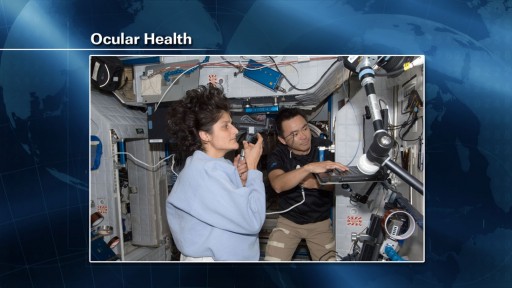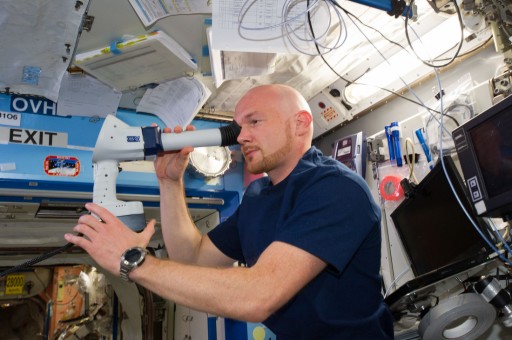Ocular Health

 A human physiology study that will keep the crew busy many days of their mission is Ocular Health. Its full name is Prospective Observational Study of Ocular Health in ISS Crews. The Prospective Observational Study of Ocular Health in ISS Crews (Ocular Health) protocol aims to systematically gather physiological data to characterize the Risk of Microgravity-Induced Visual Impairment/Intracranial Pressure on crewmembers assigned to a 6 month ISS increment,” the NASA experiment overview said.
A human physiology study that will keep the crew busy many days of their mission is Ocular Health. Its full name is Prospective Observational Study of Ocular Health in ISS Crews. The Prospective Observational Study of Ocular Health in ISS Crews (Ocular Health) protocol aims to systematically gather physiological data to characterize the Risk of Microgravity-Induced Visual Impairment/Intracranial Pressure on crewmembers assigned to a 6 month ISS increment,” the NASA experiment overview said.
It is known that some (not all) astronauts in orbit experience changes in visual acuity (visual clarity) and intraocular pressure as a result of fluid shifts within the body as it is subjected to microgravity. About 20% is astronauts flying to ISS have reported these kinds of changes. Test subjects will undergo pre-flight, flight and post-flight testing of their eyes using a variety of techniques.
Near and far visual acuity will be tested for each eye independently using a Snellen chart and Amsler grid testing. Also, intraocular and blood pressure measurements are part of the study as well as ocular ultrasounds to identify changes in globe morphology, fundoscopy to detect retinal changes, threshold visual field testing to assess central and peripheral vision changes, contrast sensitivity changes as a measure of visual function, and vascular compliance calculations. In-flight measures will be taken on Flight Days 10, 30, 60, 90, and 120 as well as 30 days prior to return.
Pre- and post-flight examinations include refraction testing, pupil reflex testing, extraocular muscle balance and function checks, CT and MRI scans and split lamp biochemistry and high resolution retinal photography.
“The purpose of this study is to collect evidence to characterize the risk and define the visual changes and central nervous system (CNS) changes observed during a six month exposure to microgravity including postflight time course for recovery to baseline. This study will gather information that can be used to assess the risk of Microgravity-Induced Visual Impairment/Intracranial Pressure (VIIP) and guide future research needs,” the experiment overview notes.
